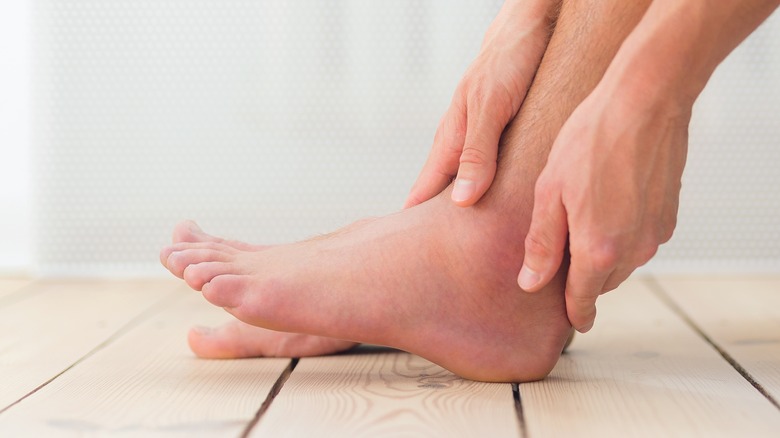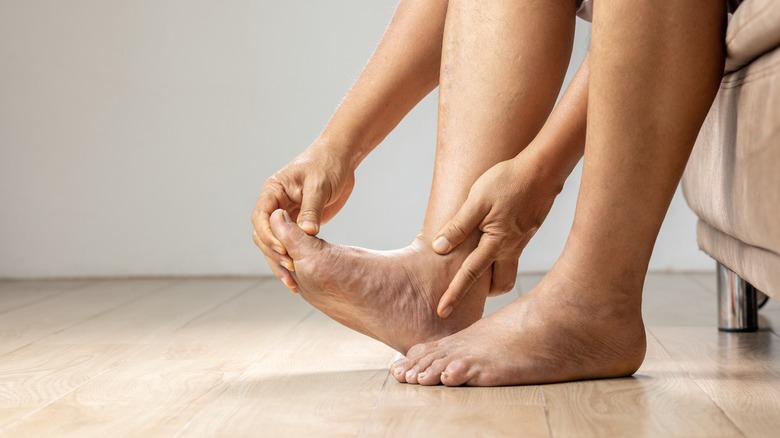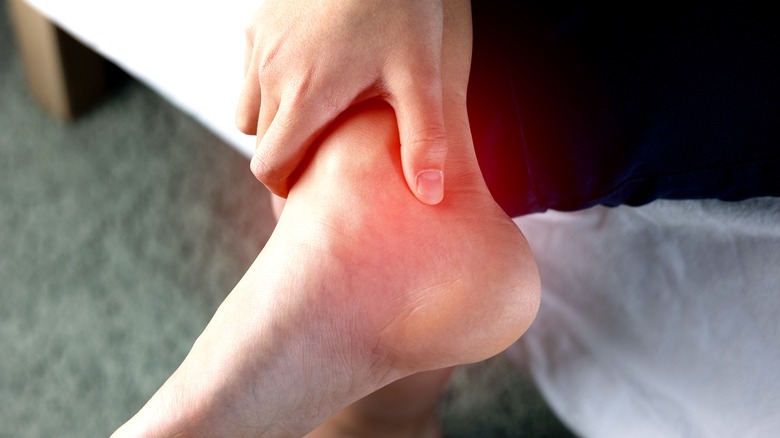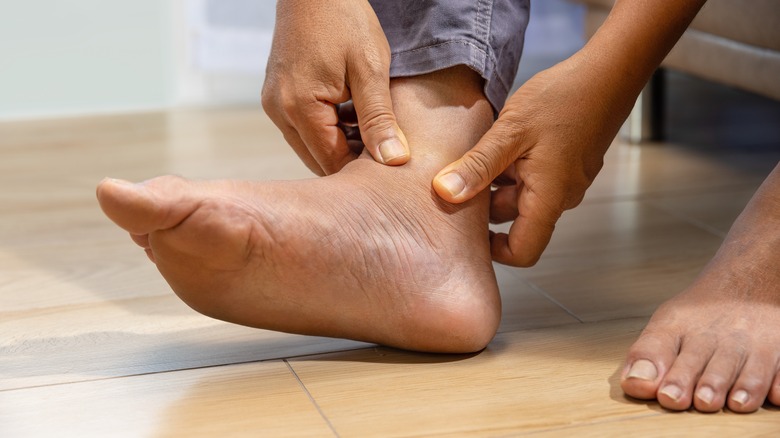10 Signs Your Ankle Pain Could Be Gout
Ankle pain can be one of life's biggest nuisances. These joints play a vital role in allowing us to move effectively, and even the tiniest twinge or ache in them can grind your activity to a halt. But while ankle pain can often be relatively minor and clear up on its own, now and again it can be caused by something more serious — and gout can be one of these things. Gout has seen a huge uptick in its prevalence in the last few decades, with the number of people who have gout doubling since the 1990s, according to research published in The Journal of Rheumatology. In the United States, roughly 9.2 million people experience gout symptoms (per the JAMA Network), and while it's commonly thought of as a condition that affects older people, men can be more susceptible to it at a younger age, particularly between around 30-50 years old, says the Mayo Clinic.
Gout causes sharp, often excruciating pain in the joints, and while it's most likely to flare up in your big toe, it can affect you in many places that your bones meet — including your ankle. But how do we know that the pain in our ankle is gout and not something else? We're here to lay out all of the signs you should keep an eye out for.
What causes gout pain?
Speak to anyone who's had gout before, and they'll likely bring up one thing pretty quickly: The pain. Gout causes sudden attacks of acute pain, which can often appear without any warning and then disappear for a matter of weeks or months, before reappearing abruptly, as the CDC states.
The rapid and unpredictable nature of this pain can make gout a mysterious condition to understand, but it all comes down to your levels of uric acid. Certain foods and drinks we consume contain compounds called purines, which are also made by our body (per Arthritis-Health). When our bodies break down these purines, uric acid is created, and this is normally processed and excreted through our bodily waste. But when our levels of uric acid are too high (known as hyperuricemia), it starts to collate into crystals that accumulate in our joints, and these crystals then cause the tissues in our joints to inflame, leading to gout attacks. It's worth noting that it's entirely possible to have hyperuricemia and not experience a gout attack or have any other symptoms — but if you do experience symptoms, or suspect your uric acid levels are too high, it's wise to discuss your situation with a doctor, as they may be able to help you limit your uric acid levels.
Pain accompanied by skin changes could be gout
If you're unsure whether your ankle pain is gout, it might be wise to consider what's happening on the outside of your body, as well as on the inside. Visible skin changes are common when it comes to gout, with your skin likely taking on a red tinge or swelling up. This is most common with acute gout attacks and is caused by what happens when uric acid builds up in your system, as the Hospital for Special Surgery rheumatologist Theodore R. Fields explains via Creaky Joints. "Urate crystals are released into the joint fluid and cause an inflammatory reaction, bringing in many white blood cells and releasing inflammatory chemicals that cause the pain, redness, and swelling," Fields states.
Your skin might also feel hot to the touch and especially tender, says Versus Arthritis. Additionally, it might look shinier than usual. As your gout attack starts to calm down, one skin change that can occur post-attack is peeling, as your skin starts to heal and regenerate. Applying a cold compress to your skin during a gout attack may help to bring redness, swelling, and pain down, although it's generally better to use this line of treatment if your pain isn't especially severe (per WebMD).
The pain usually happens at night
You're tucked up in bed, sound asleep without a care, when suddenly you're thrown into the waking world by an excruciating pain in your ankle. Sound familiar? If so, we could be talking about gout.
Pain at night is one telltale sign of gout, with gout attacks being more than twice as likely to occur during the night than in the daytime, as research published in Arthritis & Rheumatology states. There could be several reasons why this is the case. The first is down to body temperature, which gets lower while we're snoozing, enabling the uric acid crystals that cause inflammation and pain to form more easily, says Arthritis-Health. This, incidentally, is why gout is also more common in our extremities, as these tend to be a little colder than other parts of our bodies due to more limited blood flow. We can also become dehydrated while we sleep (since we're, y'know, not drinking water for eight hours), making the uric acid in our blood more concentrated. Other factors may include having lower amounts of cortisone while we're asleep, a hormone that keeps inflammation in check, and having a lower rate of breathing, leading to more carbon dioxide in the system, potentially causing higher uric acid levels.
Ankle gout pain is typically sudden
Some types of ankle pain typically deliver a dull, constant pain that follows you around throughout the day. But gout pain? It's fast. Very fast. Ankle pain caused by gout tends to ramp up very quickly and be very painful, with not very much prior warning that the pain is going to strike, explains Creaky Joints. Unfortunately, though, the pain can take a little longer to fade than it does for it to appear, with gout pain generally going away in anywhere from a few days to several weeks.
One of the strangest things about gout pain, too, is that when you're not experiencing a flare-up, it can generally be non-existent — you may have no symptoms for weeks, months, or even years. The problem, though, is that once you've had one gout attack, you may be facing more if you don't treat the condition. And the longer you go without tackling your gout, the more likely you are to experience a gout attack, and the more painful it can be when it rears its head without warning again.
Your ankle may swell up
Swelling that accompanies the pain in your ankle could be a telltale sign of gout. Although swelling can occur with other ankle conditions or injuries, the cause of swelling when it comes to gout is the buildup of uric acid in your system that also causes pain, says the Cleveland Clinic. This excess uric acid ushers in the formation of crystals in your joints, causing inflammation, which then causes an increase in size that you might see around your ankle.
If your gout is left untreated or becomes chronic, though, there can be other visible changes and swellings, beyond just a general increase in size. Over time, the urate crystals around your joint can form lumps or bumps known as tophi, as Creaky Joints states. Tophi are more common if you experience frequent gout attacks, but they're generally not painful in and of themselves unless they create pressure on another part of your ankle or become infected. Tophi can, however, "be distressing for some patients" because of how they look, states Medstar Georgetown University Hospital's rheumatologist Kaitlin A. Quinn to Creaky Joints. If your body has formed tophi, you might be pleased to know that they may not be permanent. Treating your gout as a whole to reduce your uric acid levels will also bring the size of your tophi down. For more general swelling with an acute gout attack, using NSAIDs or other anti-inflammatory medication may provide relief (via Cleveland Clinic).
Ankle gout can cause fatigue
Gout can be exhausting, y'all. And that's not just because once you've had a gout attack, you may be constantly looking over your shoulder to see when the next one will arrive. Gout in your ankle can cause fatigue alongside the pain, as Creaky Joints states. You can get so exhausted during a gout attack that it can resemble the flu in its severity, exacerbated by muscle aches and fever that can also come with the pain.
This, naturally, can make dealing with a gout attack quite difficult: Not only do you have intense pain to contend with, but tiredness too. That's why it's vital to know how to deal with a flare-up. Try as much as possible not to overexert yourself during a gout attack, and reduce stress and activity levels, as the Arthritis Foundation advises. Reducing any unnecessary stress will allow you to recover faster, while also helping to manage fatigue. It's also vital to stay hydrated. Managing your pain and symptoms with medication can also be a helpful move.
Kidney stones might accompany your pain
If you've had a gout attack, you'll know that you have enough on your plate to deal with, what with that frankly wild pain and all. But having kidney stones to contend with too? Sometimes, life really is unfair. The presence of kidney stones, however, can be a clear sign that your ankle pain isn't muscular or due to another cause — it is likely prompted by gout. The same uric acid that creates painful crystals in your joints, prompting gout pain and attacks, can also form into kidney stones, as Mount Sinai discusses.
While uric acid isn't responsible for the majority of kidney stones, hyperuricemia may cause roughly a sixth of all kidney stone cases, as research published in Medicina states. Like gout, kidney stones can be super painful, creating a one-two punch of agony for you to have to deal with. Given that gout, the kidneys, and kidney stones all have a relationship with each other, it's vital to seek treatment if you have kidney stones alongside gout. As with treating gout, trying to reduce your intake of foods high in purines or reduce uric acid levels via other means is a sensible course of action to reduce symptoms and the chance of further recurrence (per the National Kidney Foundation).
Ankle gout can result in mobility issues
When you have a gout attack, the tissue in your joints flares up and becomes inflamed, and one notable area that can be affected is your bursae, the sacs of fluids that keep your joints moving healthily (per Healthline). An inflamed bursa, known as bursitis, can prompt stiffness, which can then make moving around more difficult. Bursitis may also, in some cases, prompt infection, creating further complications and potential long-term damage to the joint.
Acute gout can also cause mobility difficulties thanks to the fact that it's very, very painful to walk or to do anything. If your gout is chronic, though, you may have mobility issues thanks to a different cause. Chronic gout causes constant low-level inflammation, as an article published by the Institute for Quality and Efficiency in Health Care states. Over time, this can alter the shape of your joints, which may further hamper mobility, made worse by the fact that your muscles can then get weaker and lose function.
Your pain will be severe
Rest assured, if your ankle pain is gout, you're likely to know about it. We realize that this may come as cold comfort to people who have gout, though, as the intensity of the pain is the sure giveaway. "A gout attack is usually not subtle," states the David Geffen School of Medicine rheumatologist and gout specialist John D. Fitzgerald via Creaky Joints. Gout attacks can cause agonizing pain, often described as needle-like, with the ankle often exhibiting a strong burning feeling that can get in the way of your day-to-day life.
This is where gout can differ from other causes of ankle pain, like different kinds of arthritis, that more commonly provide a low-level, constant ache. Usually, the severity of a gout attack peaks within 24 hours, and there will then be a drop-off in pain. When your pain is especially bad, using anti-inflammatories like NSAIDs, glucocorticoids, or colchicine may all deliver some relief. To treat and prevent attacks over the longer term, medication that focuses on lowering uric acid levels, like febuxostat, probenecid, and allopurinol, may be prescribed by your doctor.
Your ankle pain may be gout if you're eating certain foods
One way to determine whether your ankle pain might be gout is to take a look at your lifestyle and your diet. Gout is determined by having higher levels of uric acid in the body, which is caused by higher purine levels, as the Cleveland Clinic discusses. Purines can be much higher in certain types of food, with certain meats — including red meats, organs, and game meats — delivering more of the compounds. Foods that have high fructose corn syrup in them, or that have a lot of fructose generally (as many sugary foods do) may also spike your purine levels. And one of the biggest offenders is alcohol, with beer being high in purines, and alcohol more generally inhibiting purine processing through the kidneys, resulting in a buildup of purines and uric acid.
As such, following a low-purine diet is useful both to prevent gout and to manage it if you've experienced a gout attack (per WebMD). Ideally, you should try and prioritize lean protein sources like chicken breast, as well as plant-based sources like lentils or beans. Try to consume as many fruits and vegetables as possible, too. One fruit you might want to eat more of is cherries, which have been found to be effective in bringing uric acid levels down and making gout attacks less likely, according to a review published in Evidence-Based Complementary and Alternative Medicine.
Fever with your pain might mean gout
Ankle pain may be localized, and the ache you feel might be your only symptom. But if it's also accompanied by symptoms that affect other parts of your body, it may be more likely to be prompted by gout. One of these symptoms is a generalized fever, as Arthritis-Health discusses. This usually occurs when a gout attack is especially bad and affects multiple joints in the body at once, creating higher levels of inflammation that then result in a rise in body temperature. Alongside your fever could be other symptoms that you may not commonly associate with gout, like general malaise or a crummy, sick feeling.
It's important to remember, though, that fever may not necessarily indicate the presence of gout on its own, and if you have more of a dull ache or general issues with mobility, both the fever and pain may be caused by another form of arthritis. The best thing to do is to discuss your symptoms with your doctor. While it may be hard to discern that your fever is directly caused by a gout attack, it may indicate the presence of gout and open up avenues for further treatment.
Your pain may be pseudogout
While ankle pain caused by gout can be a highly painful and irritating experience, it's important to remember that unless diagnosed by a doctor, it may not be gout at all. There's another condition that prompts gout-like symptoms without being gout itself: Pseudogout. While gout pain is prompted by the build-up of uric acid crystals, pseudogout is caused by excess calcium pyrophosphate (or CPP), WebMD explains. This buildup of CPP can then create crystal formations in the joints, like gout, and cause similar symptoms.
Mercifully, though, pseudogout usually results in less severe pain than true gout. It may be less predictable than gout, however, mainly because it can be tricky to determine exactly why people get CPP buildups sometimes. CPP release may be determined by your cartilage and could be prompted by cartilage damage from an injury. Pseudogout is generally more likely to occur in older adults, particularly people more than 60 years of age. Luckily, though, it is treatable with anti-inflammatory medication or anti-gout drugs like colchicine. Your doctor may also prescribe steroids or deliver steroid injections to help bring the inflammation down.
How do I treat my gout?
While ankle gout can be a deeply unpleasant experience, the good news is that it's also pretty treatable. How you treat gout, though, depends on what stage your condition is at. The best time to catch gout is when it's still asymptomatic, as Creaky Joints explains. "In this first stage of gout, the person has no joint pain, no red or swollen joints, just an elevated uric acid blood test," states the Hospital for Special Surgery rheumatologist Theodore R. Fields. At this point, preventive measures may be taken, like reducing alcohol intake, changing the diet to reduce high-purine foods, or treating associated conditions that could raise the risk of gout.
It's worth pointing out that high uric acid levels may not lead to a gout attack, but if they do, it's important to speak to your doctor at the first opportunity. They can then work with you to manage your pain and symptoms, reduce your uric acid levels, and lower the risk of recurrence. This is also the course of action if you've recently had a gout attack and are likely to have another one. If you have chronic gout, treatment paths may be similar, and your doctor may also recommend medication to bring down your urate levels. In certain situations, such as if you develop tophi, surgery may be required (per Healthline).
What else could my ankle pain be?
While ankle pain can be created by gout, it's important not to jump to conclusions. The fact is that ankle pain may be caused by a huge variety of conditions affecting your bones, joints, tendons, or muscles, as the Cleveland Clinic states. It may even be as simple as a sprain, an injury that is characterized by damage to the ankle ligaments that may occur during a sporting activity or by simply rolling over it. Tendonitis, a condition whereby the tendons become inflamed and damaged, may also be what's creating your ankle aches.
In other situations, the pain could be created by something other than your ankle entirely. If you have flat feet, for example, your ankles can take the additional strain and become painful and inflamed due to the lack of arch support in your foot. Generally, your physician will determine what's causing your ankle pain through a series of tests, which may include an X-ray or an MRI scan. Generally, ankle pain is treated using a combination of cold therapy, resting the joint, elevating your ankle and foot, and pain or anti-inflammatory medication, but for other conditions like gout, additional treatments may be required.















